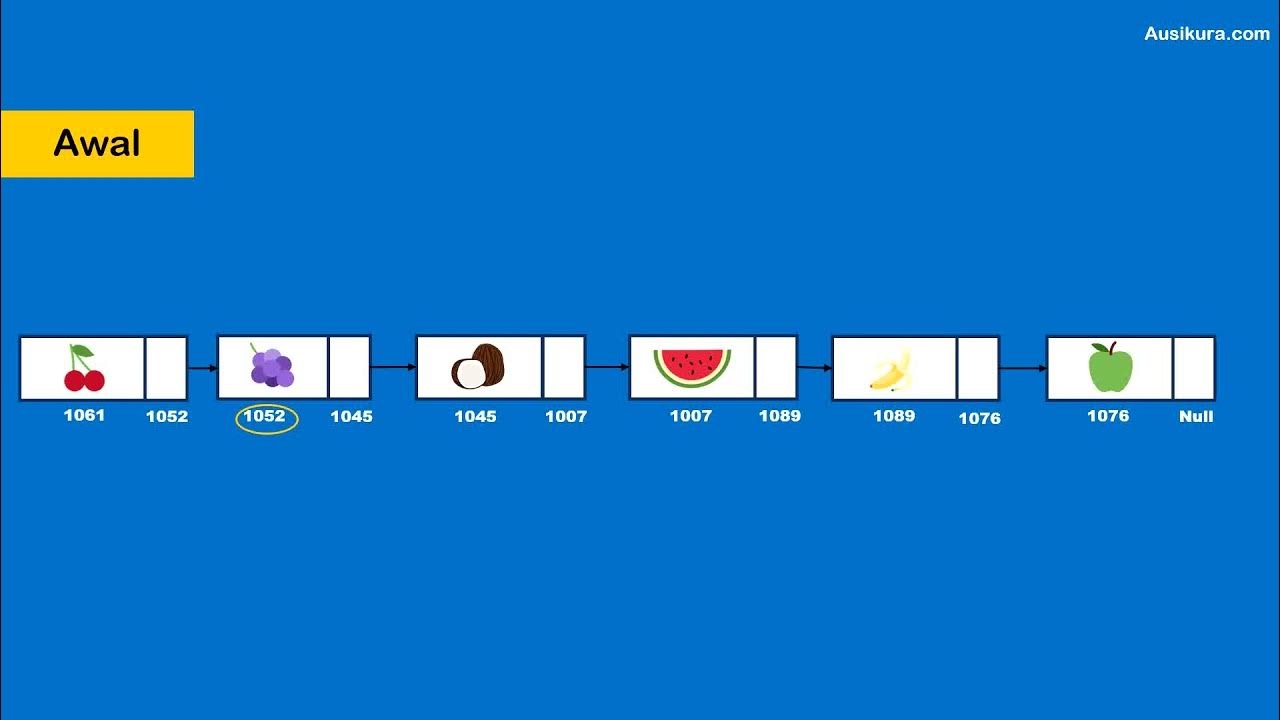Struktur Data Pertemuan 4
Summary
TLDRIn this tutorial on linked lists, the instructor explains the basic concepts, including the differences between linked lists and arrays. Key points include dynamic memory allocation in linked lists, how data is stored through pointers, and how nodes are connected sequentially. The script also covers various linked list operations such as adding and removing elements at the beginning, middle, or end, along with handling memory allocation and pointers. The instructor walks through coding examples and emphasizes the importance of understanding the logic behind linked list operations for effective programming in data structures.
Takeaways
- 😀 Linked lists are dynamic data structures that use pointers to store values in non-contiguous memory locations, unlike arrays which store data in contiguous memory.
- 😀 Linked lists can be traversed sequentially using references to the next node, starting from the head node, making them flexible for dynamic memory allocation.
- 😀 The head node in a linked list refers to the first node, and the tail node refers to the last, with the tail's pointer often pointing to null (indicating the end of the list).
- 😀 Linked lists are more suitable for situations that involve frequent insertions and deletions, as memory is allocated dynamically for each new node, unlike arrays that may require resizing.
- 😀 The single linked list consists of nodes, each with two fields: data (information) and a pointer to the next node.
- 😀 A single linked list does not store its elements in adjacent memory locations, making it easier to insert or delete nodes compared to arrays, which require shifting elements.
- 😀 Linked lists are ideal for dynamic data structures like stacks, queues, and other structures that need flexible, non-contiguous memory allocation.
- 😀 Inserting and deleting nodes in linked lists can be done at the beginning, end, or middle, with operations varying in complexity depending on the position of the node.
- 😀 To traverse a linked list, only the memory address (pointer) of the first node is needed, which reduces the need to manage complex indices like in arrays.
- 😀 Single linked lists have a simple structure with one pointer per node, but there are variations like doubly linked lists, where each node points both forward and backward.
Q & A
What is the main topic of the lesson in the video?
-The main topic of the lesson is about linked lists in data structures, focusing on their properties and how they differ from arrays.
What is the fundamental concept of a linked list as explained in the video?
-A linked list is a dynamic data structure where each item (node) contains a value and a reference (pointer) to the next item. The nodes are not stored in contiguous memory locations, unlike arrays.
How does a linked list differ from an array in terms of memory allocation?
-Unlike arrays, which require contiguous memory allocation for all elements, a linked list dynamically allocates memory for each new node as it is created, allowing for more flexible memory usage.
What is the advantage of using linked lists over arrays for dynamic data storage?
-Linked lists are more efficient when it comes to inserting or deleting elements, especially in the middle, because they don't require shifting elements like arrays do.
What is a node in a linked list?
-A node in a linked list consists of two parts: the data field, which stores the value, and the reference field, which stores the address or pointer to the next node.
What are the two main types of linked lists mentioned in the video?
-The two main types of linked lists mentioned are the singly linked list (where each node points to the next node) and the doubly linked list (where each node has pointers to both the next and previous nodes).
What is the head and tail of a linked list?
-The head is the first node in the linked list, while the tail is the last node. The tail node’s next reference points to null, indicating the end of the list.
How are elements added or removed from a linked list?
-Elements can be added or removed from the linked list at the beginning, end, or middle. Insertion at the beginning is straightforward, while insertion at the end requires traversing the list to find the last node.
What are the main operations performed on linked lists in this lesson?
-The lesson covers operations like adding elements at the beginning or end, inserting elements after a given node, deleting elements, and traversing the list.
What is the key difference between singly and doubly linked lists?
-In a singly linked list, each node has a pointer to the next node only, while in a doubly linked list, each node has pointers to both the next and the previous nodes, allowing easier traversal in both directions.
Outlines

This section is available to paid users only. Please upgrade to access this part.
Upgrade NowMindmap

This section is available to paid users only. Please upgrade to access this part.
Upgrade NowKeywords

This section is available to paid users only. Please upgrade to access this part.
Upgrade NowHighlights

This section is available to paid users only. Please upgrade to access this part.
Upgrade NowTranscripts

This section is available to paid users only. Please upgrade to access this part.
Upgrade NowBrowse More Related Video

Pengenalan Linked List - struktur Data (Animasi)

87. OCR A Level (H446) SLR14 - 1.4 Data structures part 1 - Linked lists

Arrays vs Linked Lists - Data Structures and Algorithms

Linked List Data Structure | Illustrated Data Structures

Introduction to Linked List

DATA STRUCTURES VIVA QUESTIONS AND ANSWERS | DATA STRUCTURES Interview QUESTIONS with ANSWERS
5.0 / 5 (0 votes)